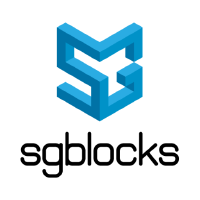Company Analysis Safe & Green Holdings Corp.
1. Summary
Advantages
- Price (0.5956 $) is less than fair price (1.5 $)
- The company's current efficiency (ROE=170.48%) is higher than the sector average (ROE=40.21%)
Disadvantages
- Dividends (0%) are below the sector average (1.2%).
- The stock's return over the last year (-46.82%) is lower than the sector average (-3.39%).
- Current debt level 113.43% has increased over 5 years from 0%.
Similar companies
2. Share price and performance
2.1. Share price
2.3. Market efficiency
| Safe & Green Holdings Corp. | Industrials | Index | |
|---|---|---|---|
| 7 days | -23.4% | -44.3% | 3.2% |
| 90 days | 51.9% | -5% | 13% |
| 1 year | -46.8% | -3.4% | 12.8% |
SGBX vs Sector: Safe & Green Holdings Corp. has significantly underperformed the "Industrials" sector by -43.43% over the past year.
SGBX vs Market: Safe & Green Holdings Corp. has significantly underperformed the market by -59.67% over the past year.
Stable price: SGBX is not significantly more volatile than the rest of the market on "NASDAQ" over the last 3 months, with typical variations of +/- 5% per week.
Long period: SGBX with weekly volatility of -0.9004% over the past year.
3. Summary of the report
4. Fundamental Analysis
4.1. Stock price and price forecast
Below fair price: The current price (0.5956 $) is lower than the fair price (1.5 $).
Price significantly below the fair price: The current price (0.5956 $) is 151.8% lower than the fair price.
4.2. P/E
P/E vs Sector: The company's P/E (0) is lower than that of the sector as a whole (33.89).
P/E vs Market: The company's P/E (0) is lower than that of the market as a whole (89.86).
4.3. P/BV
P/BV vs Sector: The company's P/BV (-0.0803) is lower than that of the sector as a whole (23.7).
P/BV vs Market: The company's P/BV (-0.0803) is lower than that of the market as a whole (9.35).
4.4. P/S
P/S vs Sector: The company's P/S indicator (0.201) is lower than that of the sector as a whole (4.29).
P/S vs Market: The company's P/S indicator (0.201) is lower than that of the market as a whole (10.1).
4.4.1 P/S Similar companies
4.5. EV/Ebitda
EV/Ebitda vs Sector: The company's EV/Ebitda (-0.5005) is lower than that of the sector as a whole (18.01).
EV/Ebitda vs Market: The company's EV/Ebitda (-0.5005) is lower than that of the market as a whole (50.71).
5. Profitability
5.1. Profitability and revenue
5.2. Earnings per share - EPS
5.3. Past profitability Net Income
Yield Trend: Rising and has grown by 52.25% over the last 5 years.
Earnings Slowdown: The last year's return (0%) is below the 5-year average return (52.25%).
Profitability vs Sector: The return for the last year (0%) is lower than the return for the sector (2.98%).
5.4. ROE
ROE vs Sector: The company's ROE (170.48%) is higher than that of the sector as a whole (40.21%).
ROE vs Market: The company's ROE (170.48%) is higher than that of the market as a whole (11.64%).
5.5. ROA
ROA vs Sector: The company's ROA (-145.86%) is lower than that of the sector as a whole (9.36%).
ROA vs Market: The company's ROA (-145.86%) is lower than that of the market as a whole (6.88%).
5.6. ROIC
ROIC vs Sector: The company's ROIC (0%) is lower than that of the sector as a whole (17.63%).
ROIC vs Market: The company's ROIC (0%) is lower than that of the market as a whole (11%).
7. Dividends
7.1. Dividend yield vs Market
Low yield: The dividend yield of the company 0% is below the average for the sector '1.2%.
7.2. Stability and increase in payments
Unstable dividends: The company's dividend yield 0% has not been consistently paid over the past 7 years, DSI=0.
Weak dividend growth: The company's dividend yield 0% has been growing weakly or stagnant over the past 5 years. Growth over only 0 years.
7.3. Payout percentage
Dividend Coverage: Current payments from income (0%) are at an uncomfortable level.
Pay for your subscription
More functionality and data for company and portfolio analysis is available by subscription
 Max Chat
Max Chat


